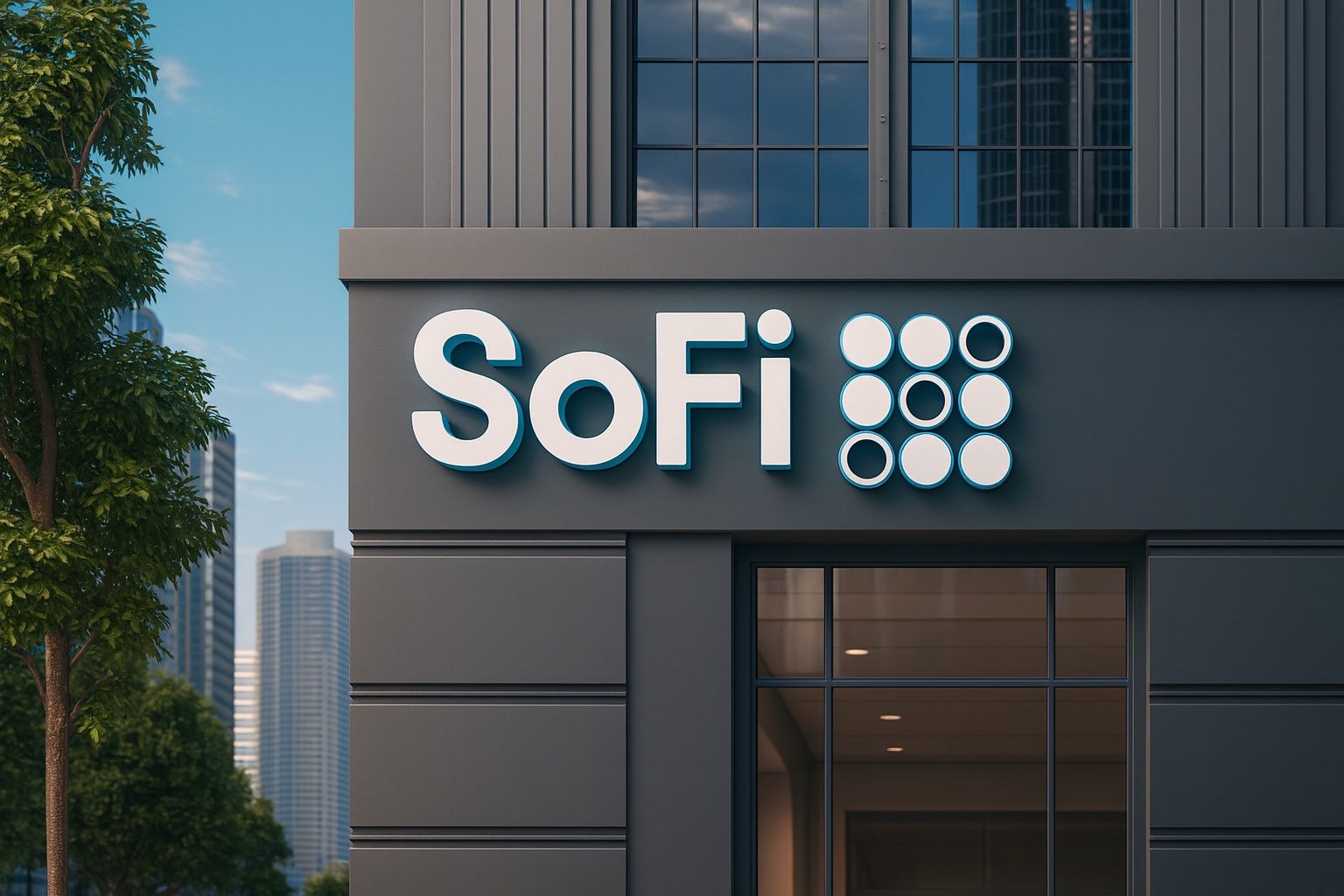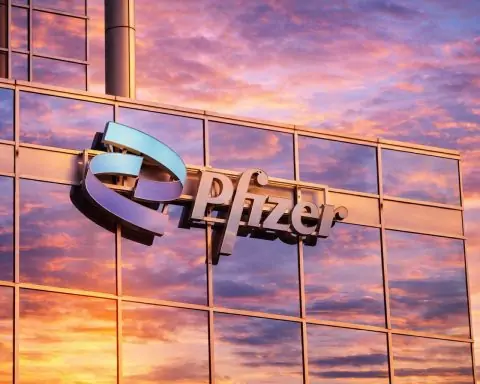- Explosive Rally: SoFi Technologies (NASDAQ: SOFI) has more than tripled over the past year (up ~230%), recently hitting a 52-week high around $30.30 in late September 2025 [1]. After a bout of profit-taking and volatility, the stock now trades near $27 (as of Oct. 16) – about 8–10% below its peak [2], yet still up ~70% year-to-date [3].
- New Offerings & Crypto Expansion: The fintech firm is rapidly expanding its product suite. In October, SoFi launched no-fee options trading for retail investors, allowing commission-free covered calls and cash-secured puts [4]. It also rolled out new crypto-powered features – CEO Anthony Noto announced plans for in-app crypto trading and blockchain-based international transfers via a partnership with Bitcoin Lightning startup Lightspark [5]. An FDIC-insured SoFi stablecoin is even in the works pending regulatory approval [6].
- Partnerships & Leadership Moves: SoFi’s Lightspark tie-up aims to enable instant, low-cost global remittances (piloting first in Mexico) [7]. Meanwhile, an executive shake-up hit its Galileo fintech unit on Oct. 1: longtime Galileo CEO Derek White resigned after four years (citing “record revenue”), and SoFi installed CFO Bill Kennedy as the new Galileo chief [8].
- Surging Financials & Q3 Outlook:Profitability is accelerating. SoFi’s Q2 2025 net income jumped to ~$97 million (from just $8M a year prior) [9]. Management hiked full-year 2025 revenue guidance to ~$3.37 B (+30% YoY) and is targeting $0.55–$0.80 in EPS by 2026 [10]. The Q3 2025 earnings report is set for Oct. 28, and Wall Street expects another strong quarter – around $0.08 EPS on $886 million revenue (≈60% YoY earnings growth) [11]. Notably, SoFi beat Q2 estimates (posting $0.08 vs. $0.06 EPS expected) and raised guidance, heightening anticipation for its upcoming results [12] [13].
- Analyst Sentiment Split:Wall Street is polarized on SOFI. Morgan Stanley and Compass Point recently cut the stock to “Sell,” arguing the ~250% rally left “the optimism… already priced in” (with price targets of ~$18 and $12) [14] [15]. In contrast, bulls like Mizuho’s Dan Dolev (Buy, ~$31 PT) cite SoFi’s “strong rate-driven outlook” and continued growth in lending as justification for a higher valuation [16]. Overall, the consensus rating is Hold with an average ~$21 target – implying 10–20% downside from current levels [17].
- Fintech Context & Valuation: SoFi’s one-stop “financial super-app” model (offering banking, loans, investing, insurance, etc.) sets it apart from niche fintech peers. Unlike buy-now-pay-later lenders like Affirm or trading-only apps like Robinhood – many of which remain unprofitable – SoFi is growing fast and posting profits [18]. Investors have assigned it a premium valuation: about 47× forward earnings, versus ~12–21× for legacy fintech players like PayPal or Block [19]. With a ~$30B market cap, SoFi is now larger than many mid-sized banks [20], reflecting lofty growth expectations.
- Insider & Investor Activity: SoFi’s torrid rise has prompted some insiders to cash out. Company executives sold roughly $425 million worth of shares over the past year (e.g. the CTO sold ~98,700 shares at ~$27.50 in September) [21]. Short interest remains modest (~9% of float) [22], and institutions hold about 38% of shares (Vanguard, Geode, and others are among top holders) [23]. Heavy trading volumes – over 80 million shares traded on Oct. 1 alone – underscore keen interest from both retail traders and institutional investors [24].
2025’s Blistering Rally and Recent Price Moves
SoFi’s stock price has been on a blistering tear in 2025, vastly outperforming the broader market. Shares have surged roughly 230% year-over-year, driven by exploding user growth and improving financial results [25]. The stock reached a 52-week high of about $30.30 on September 22, 2025, before momentum finally cooled. A subsequent pullback – including seven straight down sessions in early October – brought SOFI down to the mid-$20s [26]. By October 16, the stock was hovering around $27 per share, roughly 8–10% below its recent peak [27]. Despite this volatility, SOFI remains up over 70% in 2025 and multiples above its year-ago levels [28], a run that few large-cap stocks can match.
The recent dip is widely seen as a “healthy breather” after SoFi’s parabolic rise [29]. Trading activity has been frenzied – for instance, more than 80 million shares changed hands on October 1 [30] – signaling intense interest in the name. Analysts note SoFi’s beta is ~1.9, indicating nearly twice the volatility of the market [31]. In other words, swings in SOFI tend to be amplified, for better or worse. For now, most observers view the stock’s October pullback as a natural consolidation within an ongoing uptrend, rather than the start of any severe reversal. “It’s been a spectacular rally, so some profit-taking was inevitable,” as one analyst noted. Indeed, even after the recent cooling, SoFi’s shares remain far above their early-2024 price and firmly in bull-market territory [32].
New Products, Crypto Initiatives & Partnerships
SoFi’s breakneck growth has been fueled not just by investor enthusiasm, but by a stream of new product launches and innovations. In early October, the company made a splash by rolling out no-commission options trading for eligible members [33]. This lets SoFi’s retail customers trade basic options strategies (like covered calls and cash-secured puts) directly in the app with zero fees – a move aimed at boosting engagement on the SoFi Invest platform. The expansion into options places SoFi in more direct competition with brokers like Robinhood, but with an educational bent toward beginners. “Offering options trading with no fees is about deepening engagement and keeping our investors in-house,” SoFi’s head of investment strategy explained in a statement (per Bloomberg [34]).
At the same time, SoFi is aggressively expanding into cryptocurrency and blockchain-based services. CEO Anthony Noto recently unveiled plans to introduce “crypto-powered” features to SoFi’s app by late 2025 [35]. This will include the ability for members to buy and sell major cryptocurrencies, as well as to send international transfers via blockchain rails [36]. Notably, SoFi has partnered with Lightspark – a startup building on Bitcoin’s Lightning Network – to enable instant, low-cost cross-border payments [37]. The first pilot will launch in Mexico, allowing SoFi users to send money abroad almost instantaneously through Lightning’s network [38]. Noto said these moves will give members “faster, smarter, and more inclusive access to their money” through crypto technology [39]. Moreover, SoFi hinted at plans to issue its own FDIC-insured stablecoin (a crypto token pegged to the US dollar) once regulators give a green light [40]. If approved, a SoFi stablecoin could be used for seamless digital payments and transfers within its ecosystem – a bold foray for a regulated bank into the crypto realm.
The company has also been broadening its lineup of thematic investment products. In September, SoFi launched the SoFi Agentic AI ETF (NASDAQ: AGIQ), an exchange-traded fund focusing on companies advancing “agentic” AI technology [41]. The fund holds names like Salesforce, Tesla, and NVIDIA – firms at the forefront of the next AI wave [42]. “We’re excited to add AGIQ to our ETF suite to give members another opportunity to tap into the next evolution of AI,” said SoFi’s Head of Advice in a statement [43]. This adds to SoFi’s growing roster of in-house ETFs targeting popular themes (the company already offers ETFs for gig economy, Web3, etc.). The new AI fund underscores how SoFi is trying to position itself not just as a lender, but as a holistic financial platform catering to trendy investor interests.
Amid these expansions, SoFi experienced a notable leadership change. On October 1, the CEO of SoFi’s fintech infrastructure subsidiary Galileo stepped down in a surprise move. Derek White, who had led Galileo for over four years (through SoFi’s $1.2B acquisition of the platform), announced his departure “with record revenue” on the books and after achieving a “Rule of 40” quarter (signifying balanced growth and profit) [44]. SoFi named Bill Kennedy, Galileo’s CFO, as the new chief executive of that unit [45]. The shake-up marks the biggest exec change at SoFi in 2025, though the company thanked White for his tenure and indicated Galileo’s momentum remains strong [46]. Galileo’s tech powers accounts for numerous fintech partners (about 160 million accounts in total), so its stable leadership is key to SoFi’s B2B revenue stream. Investors will be watching how this transition plays out, though no disruption has been reported so far.
Financial Momentum and Q3 Earnings Expectations
Underpinning SoFi’s stock surge is a remarkable improvement in financial performance. The company has transitioned from a period of losses to accelerating profits as it scales. In Q2 2025, SoFi delivered net income of roughly $97 million, a gigantic leap from just $8 million a year earlier [47]. This marked one of SoFi’s strongest quarters to date, buoyed by a 43% YoY jump in revenue and significant operating leverage. The fintech’s diversified business model – spanning lending, deposits, investment products, and technology services – appears to be paying off. SoFi’s management has grown confident enough to raise full-year guidance: they now project about $3.37 billion in 2025 revenue, up 30% year-over-year, and have guided to $0.55–$0.80 in earnings per share by 2026 [48]. For context, SoFi only just turned profitable this year; hitting the upper end of that 2026 EPS range would imply robust ongoing growth in the next couple of years. The firm’s low-cost deposit base (over $12B in customer deposits) and increasing focus on fee-based products are helping margin expansion, even as it continues to invest in new offerings [49] [50].
All eyes are now on the Q3 2025 earnings report, scheduled for October 28. Wall Street analysts anticipate that SoFi will post around $0.08 in EPS on roughly $886 million of revenue [51]. That would represent about 60% higher earnings than the same quarter last year – an impressive jump, reflecting both strong top-line growth and improving efficiency. SoFi has beat consensus estimates in the past four quarters, including a surprise profit in Q2 (when $0.08 EPS came in above the $0.06 expected) [52]. Investors are now essentially expecting a repeat performance of solid growth in Q3. Particular focus will be on member and deposit growth metrics, loan originations (especially student loan refinancing volume now that federal forbearance has ended), and credit quality. SoFi’s last report showed 850,000 new members added in Q2 and continued low default rates, and similar momentum in Q3 would support the bullish case [53] [54]. Given the stock’s huge run, any slight disappointment or cautious outlook could spark volatility – but conversely, another beat-and-raise could help validate the optimism surrounding this fintech star.
Beyond earnings, a few policy factors could influence SoFi’s outlook. Notably, SoFi has a large student loan refinancing business, which has been subdued during the federal student loan payment pause. Now that repayments have resumed, SoFi hopes to see a rebound in refinancing demand. In that vein, a recent Politico report grabbed investors’ attention: it suggested the U.S. Treasury is considering selling off portions of federal student loan debt to private investors [55]. The federal student loan portfolio is enormous (around $1.6 trillion outstanding). If even a slice of it were opened to private refinancing or investment, it could create a huge opportunity for private lenders like SoFi to acquire or refinance those loans [56]. SoFi has actively lobbied for policies to encourage loan refinancing, and any move in Washington that drives borrowers toward private refinance options would be a tailwind. Of course, such policy changes are uncertain and could face political pushback. Nonetheless, it’s an example of how regulatory developments (whether in student lending or in crypto oversight) loom in the background as potential catalysts or risks for SoFi.
Bulls vs. Bears – Experts Weigh In on SOFI
After its massive rally, SoFi has become a battleground stock on Wall Street, with bulls touting its growth and bears warning on valuation. The current analyst consensus is lukewarm – a “Hold” rating – but that average masks a wide range of opinions. According to TipRanks, the stock has 5 Buy ratings, 8 Holds, and 4 Sell ratings [57]. Price targets span from the low-teens to the mid-$30s, reflecting fundamentally different narratives. The average target of ~$21.90 is well below the recent trading price, implying about 15% downside risk [58]. In other words, the typical analyst on the Street thinks SoFi’s big run-up has overshot its near-term fundamentals.
Several high-profile analysts have urged caution. For example, Morgan Stanley’s Jeffrey Adelson reiterated his Sell rating on SoFi even as he raised his price target slightly to $18. Adelson argues that after a ~250% surge in a year, “the optimism is already priced in” to SOFI shares [59]. He sees the stock’s valuation as stretched and is concerned that investors may be overly extrapolating recent growth. Similarly, Compass Point, a research boutique, slapped an Underperform (Sell) on SoFi with an even lower $12 target [60]. These bears worry that SoFi’s current market value already assumes years of flawless execution and then some. Valuation concerns also prompted a recent downgrade from Keefe, Bruyette & Woods: analyst Tim Switzer maintained a Sell rating and noted the stock’s high multiples limit its upside, even as he acknowledged SoFi’s strong near-term momentum [61] [62]. In essence, the skeptics believe SoFi’s stock price has sprinted ahead of its fundamentals, creating a risk of a pullback if growth decelerates or if the market’s appetite for high-growth fintech cools.
On the other side, bullish analysts argue that SoFi’s story still has plenty of chapters left. Mizuho’s Dan Dolev, for one, has a Buy rating and recently hiked his target to $31 [63]. Dolev points to the improving macro backdrop – specifically, the expectation that interest rates will start falling in 2024, which could boost demand for loans and lower SoFi’s funding costs [64]. He described SoFi’s prospects as a “strong rate-driven outlook” and believes the company’s expanding product ecosystem will drive continued high growth [65]. Analysts at Jefferies and Oppenheimer have also come out positive on SoFi, highlighting its success cross-selling multiple products to a sticky customer base [66]. In their view, SoFi is not just a flash-in-the-pan meme stock; it’s building a sustainable financial services franchise that can grab share from traditional banks. The recent profitability and revenue beats bolster the bull case that SoFi’s business model is scaling as intended.
Even optimistic observers, however, acknowledge that SoFi’s valuation is demanding. The stock trades at roughly 10 times trailing sales and over 45 times forward earnings [67] – multiples that assume years of rapid expansion ahead. “Most buyers are already in,” one analyst quipped regarding SoFi’s meteoric run [68], suggesting that much of the good news may be baked into the price. As Money Morning’s Joshua Enomoto noted, one of the paradoxes of a hot stock is that its very success can become a headwind: after such a huge rally, “many investors fear holding the bag” if the growth story shows any cracks [69]. That sentiment is starting to creep around the edges of the SoFi narrative. Basically, the bar has been raised – SoFi will need to keep delivering superb results to justify its valuation, and any stumble could scare off late-arriving bulls. This dynamic sets the stage for an interesting earnings release on Oct. 28, as expectations from both Wall Street and retail investors are sky-high.
Fintech Competition, Market Context, and Risks
SoFi’s rise comes amid a broader fintech boom, but also intense competition and scrutiny in the sector. The company’s ambition is to be a one-stop financial “super-app” – combining the services of a bank, broker, lender, and more under one roof. This breadth gives it an edge versus more specialized rivals. For instance, Affirm Holdings focuses on point-of-sale installment loans and remains unprofitable, while Robinhood Markets relies heavily on stock trading activity. In contrast, SoFi spans multiple product verticals (bank accounts, personal and student loans, credit cards, stock and crypto investing, insurance, and B2B tech services via Galileo) and has achieved positive earnings [70]. Its diversified model provides multiple revenue streams and cross-selling opportunities: a SoFi customer might take out a loan, refinance a student debt, start investing through SoFi’s brokerage, and direct-deposit their paycheck into a SoFi bank account – all in one app. This ecosystem approach, management argues, yields lower customer acquisition costs and higher lifetime value per user. Indeed, SoFi’s financial services segment revenue jumped 52% year-over-year in Q2 as more banking customers adopted SoFi’s investing and credit products [71].
However, investors must weigh SoFi’s rich valuation against both legacy incumbents and other fintech high-flyers. At ~$27 a share, SoFi commands roughly a $28–30 billion market capitalization, making it larger than many regional banks that have tens of millions of customers on the books [72]. SoFi’s stock currently trades around 47× forward earnings and about 9.5× sales [73] – a hefty multiple that suggests the market expects years of 20%+ growth ahead. By comparison, payment giants PayPal (PYPL) and Block (SQ) trade closer to 12–20× forward earnings [74] after their own stock pullbacks. Fintech bulls are effectively betting that SoFi deserves a tech-like growth valuation because it can continue expanding at a fintech pace and grabbing market share from traditional banks. It’s worth noting that SoFi’s ~$2.5 billion annual revenue is still a fraction of the tens of billions that old-guard banks or credit card companies generate, leaving plenty of room for growth. But the competitive moat in consumer finance isn’t especially deep – big banks like JPMorgan are introducing their own online banking features, and other fintechs (e.g. Revolut) are aiming to become “super-apps” too [75] [76]. As SoFi scales, it will have to contend with both nimble startups and banking behemoths, all vying for the same customers.
In the coming months, macroeconomic and regulatory factors could play a role in SoFi’s trajectory. A potential positive: market expectations are building that the Federal Reserve may start cutting interest rates in 2024, which would ease borrowing costs and could stimulate loan demand [77]. SoFi, which as a bank benefits from low-cost deposits, might see its interest margin squeezed slightly by lower rates – but that could be offset by higher loan originations (more people refinancing or borrowing if rates fall). On the other hand, persistently high rates would keep SoFi’s deposit costs low but might dampen loan volumes in areas like home mortgages. Regulatory scrutiny is another wild card. SoFi’s expansion into crypto (offering trading and a possible stablecoin) will attract attention from banking regulators and lawmakers – any adverse rules or pushback could slow those initiatives. Likewise, while SoFi has lobbied for clearer rules to allow student loan refinancing, a hostile regulatory environment or political backlash (for example, if consumer advocates oppose selling federal loans to private entities) could limit growth in that segment. So far, SoFi has navigated its bank charter and crypto offerings without major issue, even earning a thumbs-up from regulators to keep a crypto trading division last year under certain conditions. Still, investors will be monitoring Washington, D.C. as closely as Wall Street when it comes to SoFi’s next chapters.
Outlook: High Expectations into Year-End
With SoFi’s stock up dramatically in 2025, the stakes are high heading into the final stretch of the year. The upcoming Q3 earnings call on Oct. 28 will be a critical moment for the company to either validate the hype or temper it. If SoFi delivers another earnings beat and raises forward guidance, it could reinforce the bull case that this fintech has truly come of age – potentially propelling the stock back toward its highs. The company’s robust member growth and expanding product suite have set the stage for strong results, and management’s commentary on trends in lending (especially student loans post-moratorium) and new product adoption will be key for analysts.
However, after a 230% run-up, even good news may not move the needle like before. SoFi’s valuation already embeds a lot of optimism, and any hint of slower growth in certain areas could spark profit-taking. As one market watcher noted, it’s the “deepest irony” for a hot stock – its very success raises the bar for future success [78]. Investors big and small will be digesting whether SoFi can continue to justify its premium or whether it’s time for a breather. In the broader context, fintech remains a promising but competitive arena, and SoFi will need to execute flawlessly to maintain its edge. For now, SoFi Technologies has evolved from a scrappy student-loan disruptor into a multi-faceted financial player, and its stock has evolved into a bellwether for fintech enthusiasm. The coming weeks – from the earnings release to any signals on interest rates or loan policies – could determine if SoFi’s extraordinary 2025 rally builds even further or finally takes a pause. Either way, SOFI will be one of the most closely watched tickers on the market as the fintech firm strives to finish the year on a high note.
Sources: Financial releases and investor presentations from SoFi; ts2.tech market analysis; Bloomberg; TipRanks; Money Morning; Nasdaq/Zacks; company press releases and reputable financial media [79] [80]. All information is up to date as of October 16, 2025.
References
1. ts2.tech, 2. ts2.tech, 3. ts2.tech, 4. ts2.tech, 5. ts2.tech, 6. ts2.tech, 7. ts2.tech, 8. ts2.tech, 9. ts2.tech, 10. ts2.tech, 11. ts2.tech, 12. ts2.tech, 13. ts2.tech, 14. ts2.tech, 15. ts2.tech, 16. ts2.tech, 17. ts2.tech, 18. ts2.tech, 19. ts2.tech, 20. ts2.tech, 21. ts2.tech, 22. ts2.tech, 23. ts2.tech, 24. ts2.tech, 25. ts2.tech, 26. ts2.tech, 27. ts2.tech, 28. ts2.tech, 29. ts2.tech, 30. ts2.tech, 31. ts2.tech, 32. ts2.tech, 33. ts2.tech, 34. ts2.tech, 35. ts2.tech, 36. ts2.tech, 37. ts2.tech, 38. ts2.tech, 39. ts2.tech, 40. ts2.tech, 41. ts2.tech, 42. ts2.tech, 43. ts2.tech, 44. ts2.tech, 45. ts2.tech, 46. ts2.tech, 47. ts2.tech, 48. ts2.tech, 49. www.nasdaq.com, 50. ts2.tech, 51. ts2.tech, 52. ts2.tech, 53. www.nasdaq.com, 54. www.nasdaq.com, 55. ts2.tech, 56. ts2.tech, 57. www.tipranks.com, 58. www.tipranks.com, 59. ts2.tech, 60. ts2.tech, 61. www.tipranks.com, 62. www.tipranks.com, 63. ts2.tech, 64. www.inkl.com, 65. ts2.tech, 66. ts2.tech, 67. ts2.tech, 68. ts2.tech, 69. ts2.tech, 70. ts2.tech, 71. ts2.tech, 72. ts2.tech, 73. ts2.tech, 74. ts2.tech, 75. www.nasdaq.com, 76. www.nasdaq.com, 77. www.inkl.com, 78. ts2.tech, 79. ts2.tech, 80. ts2.tech








